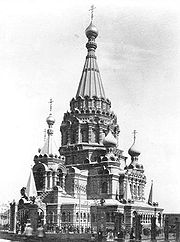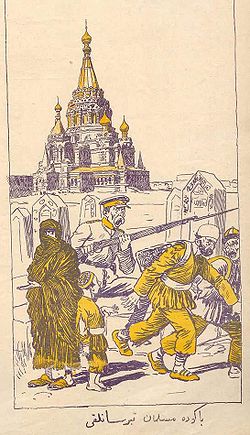
Alexander Nevsky Cathedral, Baku
Encyclopedia

Azerbaijani language
Azerbaijani or Azeri or Torki is a language belonging to the Turkic language family, spoken in southwestern Asia by the Azerbaijani people, primarily in Azerbaijan and northwestern Iran...
: Aleksandr Nevski Başkilsəsi, often referred to as Qızıllı kilsə – "The Gilt Church") was the main Russian Orthodox
Russian Orthodox Church
The Russian Orthodox Church or, alternatively, the Moscow Patriarchate The ROC is often said to be the largest of the Eastern Orthodox churches in the world; including all the autocephalous churches under its umbrella, its adherents number over 150 million worldwide—about half of the 300 million...
cathedral in Baku
Baku
Baku , sometimes spelled as Baki or Bakou, is the capital and largest city of Azerbaijan, as well as the largest city on the Caspian Sea and of the Caucasus region. It is located on the southern shore of the Absheron Peninsula, which projects into the Caspian Sea. The city consists of two principal...
, Azerbaijan
Azerbaijan
Azerbaijan , officially the Republic of Azerbaijan is the largest country in the Caucasus region of Eurasia. Located at the crossroads of Western Asia and Eastern Europe, it is bounded by the Caspian Sea to the east, Russia to the north, Georgia to the northwest, Armenia to the west, and Iran to...
from 1898, when it was built until its destruction in 1936 during the Joseph Stalin
Joseph Stalin
Joseph Vissarionovich Stalin was the Premier of the Soviet Union from 6 May 1941 to 5 March 1953. He was among the Bolshevik revolutionaries who brought about the October Revolution and had held the position of first General Secretary of the Communist Party of the Soviet Union's Central Committee...
era. The cathedral is also known as the biggest Russian Orthodox structure ever built in the South Caucasus
South Caucasus
The South Caucasus is a geopolitical region located on the border of Eastern Europe and Southwest Asia also referred to as Transcaucasia, or The Trans-Caucasus...
.
Construction

Most Holy Synod
The Most Holy Governing Synod was the highest governing body of the Russian Orthodox Church between 1721 and 1918, when the Patriarchate was restored. The jurisdiction of the Most Holy Synod extended over every kind of ecclesiastical question and over some that are partly secular.The Synod was...
supported his idea of building a new cathedral and suggested that it should be erected on Persidskaya St. (present-day Mukhtarov St.), on a vast piece of land, which would have been formed after demolishing an old Muslim
Muslim
A Muslim, also spelled Moslem, is an adherent of Islam, a monotheistic, Abrahamic religion based on the Quran, which Muslims consider the verbatim word of God as revealed to prophet Muhammad. "Muslim" is the Arabic term for "submitter" .Muslims believe that God is one and incomparable...
cemetery. This led to a ten-year debate between the authorities and the Muslim community of Baku. All proposed alternatives were turned down and at the end Muslims gave in. On 8 October 1888, Emperor Alexander III
Alexander III of Russia
Alexander Alexandrovich Romanov , historically remembered as Alexander III or Alexander the Peacemaker reigned as Emperor of Russia from until his death on .-Disposition:...
and his family (including his elder son, future Emperor Nicholas II
Nicholas II of Russia
Nicholas II was the last Emperor of Russia, Grand Prince of Finland, and titular King of Poland. His official short title was Nicholas II, Emperor and Autocrat of All the Russias and he is known as Saint Nicholas the Passion-Bearer by the Russian Orthodox Church.Nicholas II ruled from 1894 until...
) visited Baku for the ceremony of laying the first stone. The ceremony was attended by Baku's Christian
Christian
A Christian is a person who adheres to Christianity, an Abrahamic, monotheistic religion based on the life and teachings of Jesus of Nazareth as recorded in the Canonical gospels and the letters of the New Testament...
, Muslim and Jewish elite.
The cathedral was one of a series built across the Russian Empire
Russian Empire
The Russian Empire was a state that existed from 1721 until the Russian Revolution of 1917. It was the successor to the Tsardom of Russia and the predecessor of the Soviet Union...
in honour of St. Alexander Nevsky. It was designed by the German-born architect Robert Marfeld and his apprentice, Polish
Poland
Poland , officially the Republic of Poland , is a country in Central Europe bordered by Germany to the west; the Czech Republic and Slovakia to the south; Ukraine, Belarus and Lithuania to the east; and the Baltic Sea and Kaliningrad Oblast, a Russian exclave, to the north...
-born architect Józef Gosławski. The Saint Basil's Cathedral
Saint Basil's Cathedral
The Cathedral of the Protection of Most Holy Theotokos on the Moat , popularly known as Saint Basil's Cathedral , is a Russian Orthodox church erected on the Red Square in Moscow in 1555–61. Built on the order of Ivan the Terrible to commemorate the capture of Kazan and Astrakhan, it marks the...
and the Cathedral of Christ the Saviour
Cathedral of Christ the Saviour (Moscow)
The Cathedral of Christ the Saviour is a Church in Moscow, Russia, on the northern bank of the Moskva River, a few blocks south-west of the Kremlin...
were used as models for the exterior and the interior of the Alexander Nevsky Cathedral respectively. However, the funding provided by the emperor was not enough to finish the construction. Donations worth 200,000 roubles collected from the residents of Baku made it possible for the construction to continue. It is noteworthy, that despite previous disagreements, about 75% of that money was donated by Muslims, including 10,000 roubles paid in by Zeynalabdin Taghiyev. Another 10,000 roubles were provided by the Jewish community of Baku. The building of the cathedral was finally completed in 1898. Its domes, crosses and the main arch were made of pure gold. 85 meters long, 55 meters long and 44 meters wide, it was the largest Russian Orthodox place of worship in the entire Caucasus
Caucasus
The Caucasus, also Caucas or Caucasia , is a geopolitical region at the border of Europe and Asia, and situated between the Black and the Caspian sea...
at the time.
Later years
The Alexander Nevsky Cathedral remained the primary centre of Eastern Orthodox life in Azerbaijan in the early SovietSoviet Union
The Soviet Union , officially the Union of Soviet Socialist Republics , was a constitutionally socialist state that existed in Eurasia between 1922 and 1991....
era, much to the Soviet government's displeasure. In 1936, the cathedral was ordered to be blown up with dynamite along with St. Bartholomew's Chapel. Located not far from City Hall, the site where the Nevsky Cathedral once stood is now occupied by the Bulbul School of Music.
See also
- Holy Myrrhbearers CathedralHoly Myrrhbearers CathedralHoly Myrrhbearers Cathedral is a Russian Orthodox cathedral in Baku, Azerbaijan. The church is dedicated to the Holy Myrrhbearers, who are commemorated on the second Sunday after Pascha .-History:...
- Church of Michael ArchangelChurch of Michael Archangel, BakuChurch of Michael Archangel or Flotskaya is a Russian Orthodox church in central Baku, Azerbaijan, on Zargarpalan street. The church is dedicated to St. Michael...

